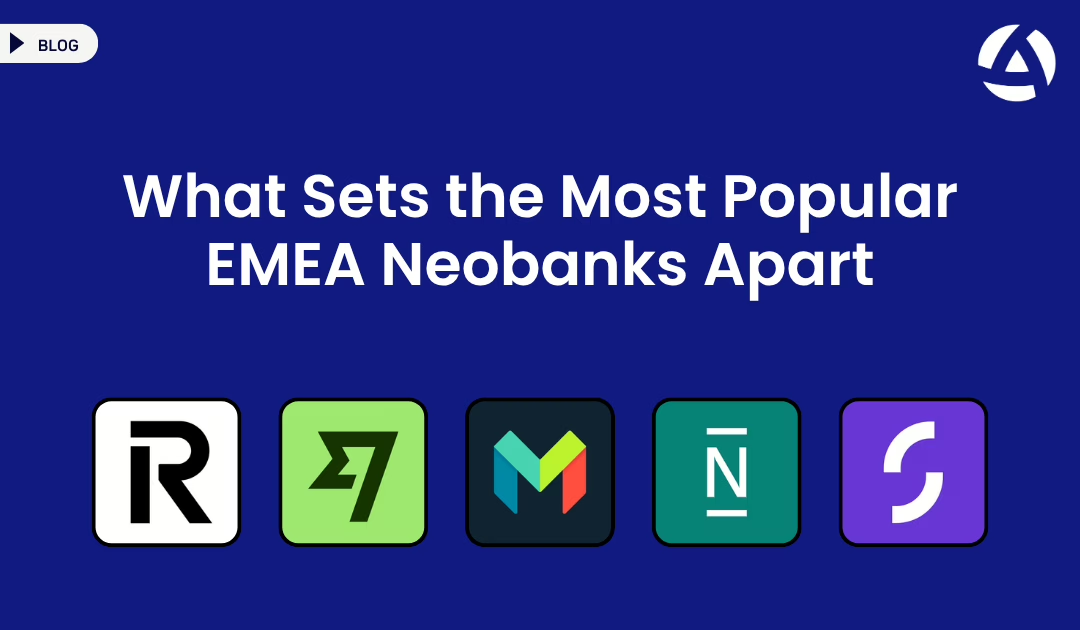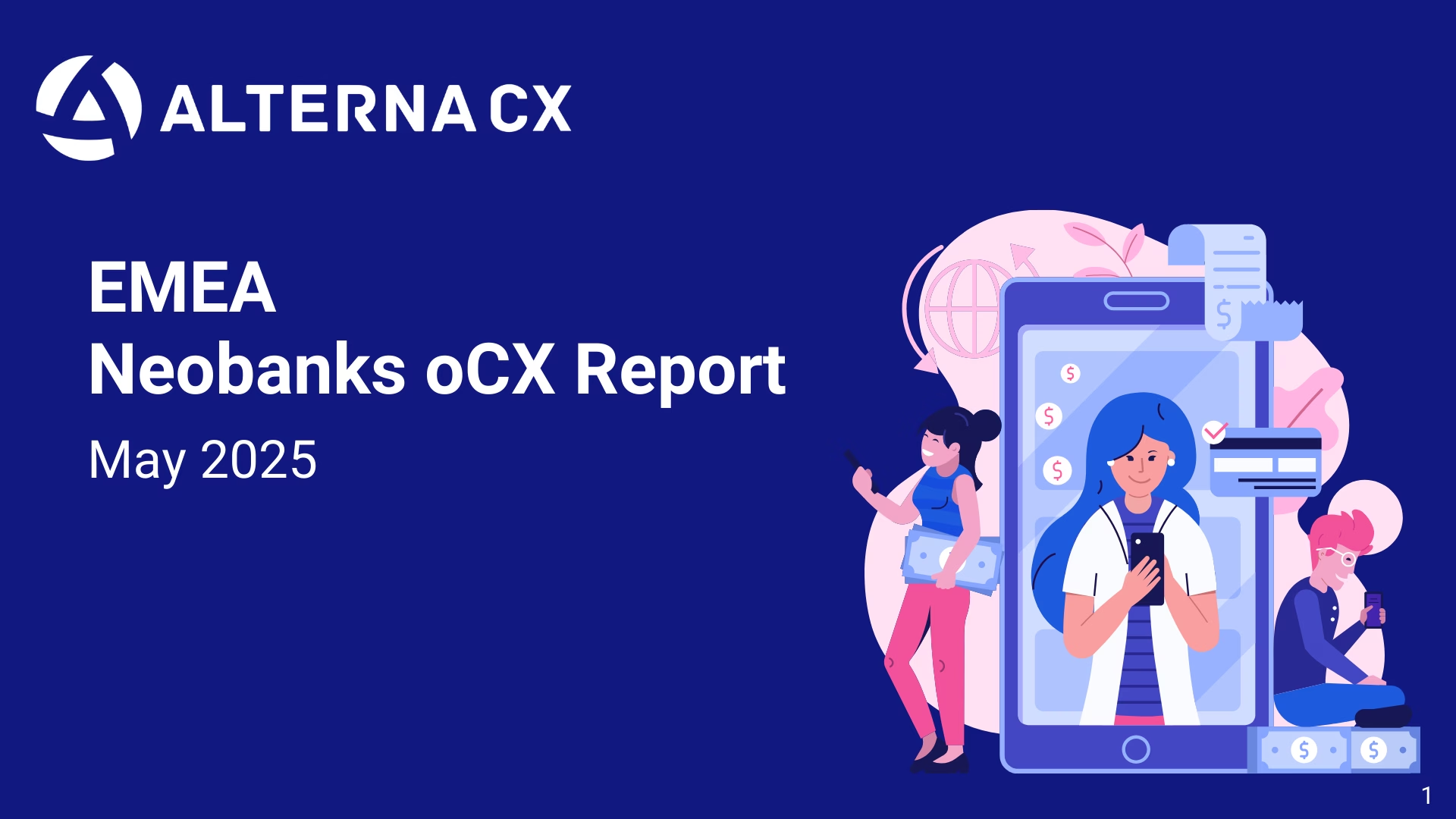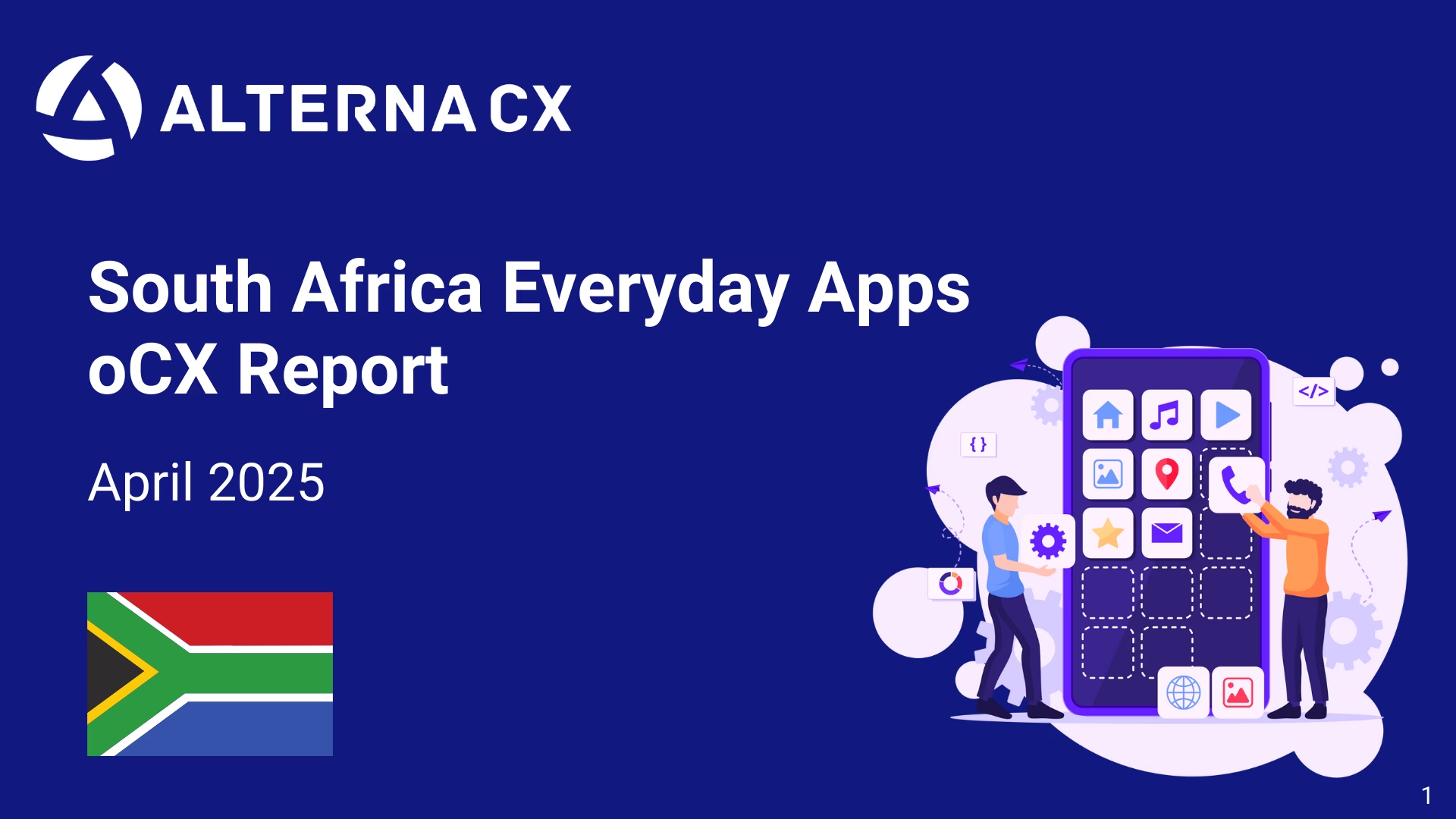For customers, this analysis reveals a clear choice: the gap between the best and rest in EMEA digital banking is substantial and likely growing. With the most popular neobanks achieving exceptional satisfaction on app usability (92%) while delivering superior money transfer experiences and more acceptable fee structures, the quality of your chosen neobank significantly impacts your daily financial experience.
In the rapidly evolving landscape of European digital banking, five neobanks have emerged as clear market leaders, establishing a performance gap so significant it fundamentally redefines what customers expect from digital financial services. Our recent EMEA Neobanks oCX Report reveals that Revolut, Wise, Monzo, N26, and Starling Bank aren’t just leading the EMEA neobank sector—they’re operating in an entirely different competitive universe.
With an average oCX score of 51 compared to just 24 for the rest of the EU neobank market, these five institutions have created a digital banking experience that sets new industry standards. But what drives this exceptional performance from the most popular neobanks, and what does it mean for both customers and competitors in the evolving fintech landscape?
The Numbers Paint a Stark Picture
The overall sentiment analysis reveals the magnitude of the most popular neobanks’ dominance across the EMEA neobank sector:
Most Popular Neobanks: 68% positive sentiment, 15% neutral, 17% negative
Rest of EU Neobanks: 50% positive sentiment, 24% neutral, 26% negative
This 18-percentage point advantage in positive sentiment, combined with substantially lower negative sentiment (17% vs 26%), demonstrates that the leading neobanks have achieved something their competitors haven’t: the ability to consistently delight rather than merely satisfy their customers.
The oCX score differential tells an even more dramatic story. The most popular neobanks’ average score of 51 represents more than double the performance of other EU neobanks, which manage only 24. This isn’t just a competitive advantage—it’s evidence of fundamentally different approaches to digital banking execution.
App Usability: The Foundation of Digital Excellence
Perhaps the most striking performance gap appears in app usability, where the most popular neobanks have achieved exceptional user satisfaction:
Most Popular Neobanks: 92% positive sentiment, 5% neutral, 3% negative
Rest of EU Neobanks: 85% positive sentiment, 8% neutral, 8% negative
While a 7-percentage point advantage might seem modest, the context reveals its significance. The most popular neobanks have managed to create interfaces that satisfy more than nine out of ten users—a remarkable achievement in any digital product category. More importantly, their negative sentiment rate of just 3% represents best-in-class performance that traditional financial institutions can only aspire to achieve.
Even more revealing is that the “rest of EU neobanks” category, despite representing newer, supposedly more agile institutions, still generates 8% negative sentiment on basic usability. This suggests that building intuitive financial interfaces requires more than just modern technology—it demands deep expertise in user experience design and rigorous testing methodologies.
Money Transfers: A Challenging Area for All Neobanks
The money transfer functionality reveals both the most dramatic performance gap and a sector-wide challenge:
Most Popular Neobanks: 48% positive sentiment, 28% neutral, 24% negative
Rest of EU Neobanks: 14% positive sentiment, 40% neutral, 46% negative
This represents a staggering 34-percentage point advantage in positive sentiment for the most popular neobanks, yet even these leaders struggle to achieve majority positive sentiment in this critical area. The high neutral sentiment across both groups (28% for most popular, 40% for others) often reflects users who can successfully transfer money but encounter minor friction points—such as delayed notifications, unclear status updates, or multi-step verification processes that, while functional, create uncertainty during transactions.
For the most popular neobanks, nearly one in four users still expresses negative sentiment about money transfers, while their competitors face an alarming situation where nearly half their users (46%) are dissatisfied with this core functionality. The 40% neutral sentiment among smaller neobanks suggests users can complete transfers but often with enough friction to prevent positive experiences.
Most concerning for smaller neobanks is the combination of low positive sentiment (14%) and high negative sentiment (46%), indicating that money transfers represent a fundamental competitive weakness that directly impacts customer satisfaction and retention.
App Speed: A Closer Performance Gap
App speed performance shows the smallest difference between the most popular neobanks and their competitors:
Most Popular Neobanks: 88% positive sentiment, 7% neutral, 5% negative
Rest of EU Neobanks: 83% positive sentiment, 11% neutral, 6% negative
The 5-percentage point gap in app speed is notably smaller than the dramatic differences seen in other categories like money transfers (34 points) and fees (32 points). This suggests that app speed represents an area where most neobanks have achieved relatively strong performance, with even smaller players managing to deliver satisfactory technical performance.
However, this consistency across all measured categories—usability, money transfers, and speed—reveals that the most popular neobanks haven’t succeeded by excelling in one area while accepting weaknesses in others. Instead, they’ve achieved systematic excellence that creates a holistic superior user experience.
Fees: A Challenging Area Across the Sector
Fee structures represent another critical area that proves difficult for all neobanks, though the most popular neobanks maintain a significant competitive advantage:
Most Popular Neobanks: 44% positive sentiment, 28% neutral, 28% negative
Rest of EU Neobanks: 12% positive sentiment, 38% neutral, 50% negative
The 32-percentage point advantage in positive sentiment reveals how the leading neobanks have managed to create fee structures that customers find more acceptable in an industry where fees remain inherently challenging for all players. Notably, even the most popular neobanks struggle to achieve majority positive sentiment on fees, with 28% negative sentiment indicating this remains a difficult area to master.
More concerning for smaller neobanks is that half (50%) of their users express negative sentiment about fees, creating a significant competitive vulnerability. The high neutral sentiment among competitors (38%) suggests users may be uncertain about fee structures or find them complex to understand, while the most popular neobanks’ more balanced distribution indicates clearer fee communication and more acceptable pricing models, even though fees remain a sector-wide challenge.
The Trust and Retention Advantage
These performance differences translate into substantial business advantages for the most popular neobanks:
Customer Acquisition: Superior app experiences drive higher conversion rates from trial to active usage, as users quickly recognize the quality differential.
Feature Adoption: With 92% positive sentiment on usability, customers of the most popular neobanks are more likely to explore and adopt new features, increasing customer lifetime value.
Word-of-Mouth Growth: The 18-percentage point advantage in overall positive sentiment translates to significantly higher Net Promoter Scores and organic growth rates.
Competitive Protection: Users experiencing consistently superior service across all touchpoints develop stronger switching barriers, protecting against competitive offers.
Operational Efficiency: Lower negative sentiment rates across all categories translate to reduced customer service costs and higher team productivity.
The Challenge for Emerging Neobanks
For the remaining players in the EMEA neobank sector, the most popular neobanks’ performance establishes both an inspirational benchmark and a daunting competitive challenge. The gap between leaders and followers—68% vs 50% positive sentiment overall, and oCX scores of 51 versus 24—represents more than statistical differences; it reflects fundamentally different organizational capabilities.
Particularly concerning is the systematic nature of the performance gaps. This isn’t a single area of weakness that could be addressed through focused improvement—it’s comprehensive underperformance that suggests deeper challenges in product development, user experience design, and platform engineering.
The money transfer performance gap alone—48% vs 14% positive sentiment—represents the kind of core functionality deficit that can define a neobank’s competitive position for years.
What Sets the Leaders Apart
The success of Revolut, Wise, Monzo, N26, and Starling Bank demonstrates several key principles:
User Experience First: Achieving 92% positive sentiment on app usability requires treating UX design as a core competency, not an afterthought.
Technical Excellence: Maintaining 88% positive sentiment on app speed while scaling to millions of users demands sophisticated engineering capabilities.
Fee Transparency: Achieving 44% positive sentiment on fees—compared to competitors’ 12%—shows the importance of clear, fair pricing structures.
Feature Execution: The 34-percentage point advantage in money transfer satisfaction shows that having features isn’t enough—executing them exceptionally is what matters, even though this remains a challenging area across the sector.
Systematic Approach: Excellence across all categories indicates these neobanks have built organizational capabilities that ensure consistent quality delivery.
The Path Forward for Competitors
For emerging neobanks, closing these gaps will require more than incremental improvements. With competitors showing 46% negative sentiment on money transfers compared to the most popular neobanks’ 24%, and 50% negative sentiment on fees versus 28%, the challenge extends beyond feature additions to fundamental platform capabilities and pricing strategy overhauls.
The most successful path forward likely involves:
Specialization Strategy: Rather than trying to match the most popular neobanks across all dimensions, focus on achieving exceptional performance in specific use cases or customer segments.
Partnership Approach: Leveraging the infrastructure and capabilities of leading players through white-label solutions or strategic partnerships.
Geographic Focus: Concentrating resources on specific markets where local expertise and regulatory relationships can create competitive advantages.
Niche Excellence: Building superior experiences for specific customer needs that the most popular neobanks haven’t fully addressed.
The Future of EMEA Digital Banking
The dominance of the most popular EMEA neobanks represents more than current market leadership—it establishes new expectations for what digital financial services should deliver. By achieving 68% positive sentiment while competitors manage only 50%, and oCX scores more than double their nearest rivals, these institutions have redefined the standards for digital banking excellence.
For customers, this analysis reveals a clear choice: the gap between the best and rest in EMEA digital banking is substantial and likely growing. With the most popular neobanks achieving exceptional satisfaction on app usability (92%) while delivering superior money transfer experiences and more acceptable fee structures, the quality of your chosen neobank significantly impacts your daily financial experience.
For the broader financial services industry, the success of Revolut, Wise, Monzo, N26, and Starling Bank demonstrates that exceptional digital banking experiences aren’t accidents—they’re the result of sustained investment in user experience, technical excellence, and systematic execution over time.
The EMEA neobank landscape has evolved beyond the early days when simply being “digital-first” was sufficient for success. Today’s leaders have shown that winning in digital banking requires not just modern technology, but world-class execution across every aspect of the customer experience.
The most popular neobanks have set the standard for what digital banking can be—and they’ve created a competitive moat that will define the industry for years to come.
To see more insights and detailed analysis, download our EMEA Neobanks oCX Report.
(Revolut, Wise, Monzo, N26, Starling Bank)




